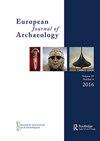青铜时代安纳托利亚的盐生产和消费模式模型
IF 1.4
2区 历史学
0 ARCHAEOLOGY
引用次数: 0
摘要
尽管安纳托利亚的盐在该地区丰富,但其采购和使用受到的学术关注有限。这项研究综合了地质、考古、民族考古和文本数据,以评估盐在公元前3000年至公元前1730年安纳托利亚社会经济环境中的作用。岩盐和盐罐的易得性使盐在那个时代的战略控制材料中排名较低。作者认为,早期非国家安纳托利亚社区获取和分配这种盐的策略是由社区驱动的。与美索不达米亚和欧洲的社会不同,在这些社会中,盐的生产和分配对其政治经济做出了重大贡献,盐从未成为一种声望商品,也没有为青铜时代安纳托利亚的财富积累做出贡献。本文章由计算机程序翻译,如有差异,请以英文原文为准。
A Model of Salt Production and Consumption Patterns in Bronze Age Anatolia
The procurement and use of salt in Anatolia has received limited scholarly attention despite its abundance in the region. This study synthesizes geological, archaeological, ethnoarchaeological, and textual data to assess the role of salt within the socioeconomic setting of the third and early second millennia bc (c. 3000–1730 bc) in Anatolia. The easy accessibility of rock salt and saltpans ranks salt lower among the strategically controlled materials of the era. The author argues that the early non-state Anatolian communities’ strategy for obtaining and distributing this salt was community-driven. Unlike societies in Mesopotamia and Europe, for which the production and distribution of salt contributed significantly to their political economy, salt never became a prestige good, nor did it contribute to the accumulation of wealth in Bronze Age Anatolia.
求助全文
通过发布文献求助,成功后即可免费获取论文全文。
去求助
来源期刊

European Journal of Archaeology
ARCHAEOLOGY-
CiteScore
3.40
自引率
6.70%
发文量
58
期刊介绍:
The publication organ of the European Association of Archaeologists, the European Journal of Archaeology seeks to promote open debate amongst archaeologists committed to a new idea of Europe in which there is more communication across national frontiers and more interest in interpretation. The journal accepts not only new empirical data and new interpretations of the past but also encourages debate about the role archaeology plays in society, how it should be organized in a changing Europe, and the ethics of archaeological practice. All periods are covered; papers, review articles, interviews and short "debate" pieces are all sought. Whilst English is the primary language of publication in the EJA, papers submitted in French or German will be given equal consideration.
 求助内容:
求助内容: 应助结果提醒方式:
应助结果提醒方式:


